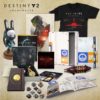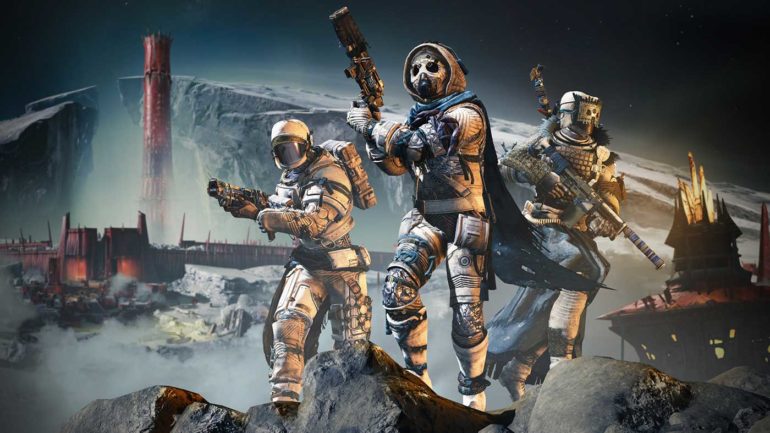After slipping the shackles of servitude to Activision, Bungie has really tackled the last few months of Destiny’s journey with reinvigorated enthusiasm throughout the lead-up to Shadowkeep, their first major expansion since acquiring the rights from Activision earlier in the year.
It’s expected to be a broad all-encompassing release that touches every facet of what makes Destiny whole. In Guardians’ return to the Moon, they’ll be treated to new story missions, new playspaces on the lunar surface, as well as new PVP maps. They’ll be bringing with them all of the tricks they learned throughout their time crafting destinations in Destiny 2 to breathe new life into what was, in retrospect, a rather barren area way back when Peter Dinklage gave it his almost-all as our plucky little Ghost.
Releasing concurrent to Shadowkeep is the revamped Armor 2.0 system that completely reinvents how players will approach load outs and gearing up for different events, it’s a brilliant quality of life change that’ll be playable for New Light adopters who take advantage of the game’s new free-to-play model that includes everything released up until Forsaken. That includes the base game and both Curse of Osiris and Warmind campaigns along with a bevy of PVE strikes, PVP modes and, of course, the exceptionally fun blend of PVP and PVE, Gambit.
Back at Gamescom 2019, we got to sit down with producer Scott Taylor and UI/UX designer Orvar Halldorsson about Shadowkeep and the changes coming to Destiny when it releases on October 1.
There’s a lot going on in Shadowkeep, what was behind the decision to return to the Moon?
ST: We got really excited about having this darker theme, and so once we settled on Eris we thought the Moon would be cool. There’s also something about the fantasy of the Moon, it’s a place you can look up in the sky and see and so we love the idea of going back and seeing what’s happened since the players in Destiny saw it.
We’re also adding all these new areas and building on the things that we’ve learned from the destinations in Destiny 2, like adding Lost Sectors, having these awesome collectibles and having a destination unfold like The Dreaming City.
I’m very excited for more Hive lore, I’ve always found it to be the most fascinating part of Destiny’s narrative backbone.
ST: Oh yeah, do you practice Sword Logic?
I’ve been known to! So, the marketing suggests Eris Morn will be a central figure of this expansion?
ST: Yeah, she is. It’s all about what’s going on with her, she uncovers something and we kind of follow that story. There’s a lot shrouded in mystery, we think it’s going to be exciting for players to unpack all of that. But she’s definitely the centerpiece of the story, yeah.
We got a look at Armor 2.0 and how artefacts work to artificially raise your power level. Are they going to translate into modes like Iron Banner and Trials of Osiris?
OH: Yeah, the soft level cap is 960, but you’ll be able to do more with artefacts in a given season. As for activities that are bound to power, artefacts will affect those but it resets season to season.
ST: I do feel bound to say, you casually slipped in Trials there and we don’t have anything to announce about that.
How liberating has the gaining of your independence been for you guys? There seems to be a real enthusiasm about this expansion.
ST: Previously a lot of those publishing functions were up to Activision so we’ve got team members who are now able to interact more directly with some of the publishing roles and see how important that work is. So there’s a lot of enthusiasm about that, but Bungie’s always been in control of where Destiny’s creative path is going, so that part is not really that different.
Gamers can be a little fickle when it comes to reused assets and developer trickery, for lack of a better term, how many new playspaces can we expect on the Moon and how many have been reskinned?
ST: I don’t think there’s any developer trickery going on here, I think we’ve taken the Moon and seen a cool storytelling opportunity. Here’s a place that’s been altered by the events of the narrative, and then there are all these new places. There’s a lot of effort that goes into bringing something like this back, if you compare screenshots you’ll notice that.
So it’s similar to Rise of Iron when SIVA infected the playspaces, altering it in profound ways?
ST: Yes, very similar. Except now we’ve had the benefit of learning about how destinations should work and how to tell stories from, say, Forsaken and Warmind. Of course, there were no Lost Sectors in Destiny and so we took that fantasy of going to the Moon and expanded on it, that’s what you’ll experience in Shadowkeep.
After Forsaken and what happened with Cayde-6, who’s role is Nolan North stealing this time?
ST: (laughs) I dunno, no-one else has died or anything so I think Nolan North is just our awesome Ghost this time around.
Are there going to be a lot of Easter Eggs that legacy players might notice?
OH: I don’t know that we’d call them Easter Eggs but there’s definitely going to be really interesting secrets. We’re trying harder to spread the lore right across the game, rather than just let it unfold through the story.
I noticed in the trailer there’s Crota and Ghaul appearing as phantasms almost, is there reintroduction tied to the Nightmare Hunt mode at all?
ST: I dunno if we’re saying all that stuff yet, Nightmare Hunt is definitely something that was revealed on the map. It’s obviously part of the Moon destination for Shadowkeep, which is all shrouded in mystery so we really don’t want to go into that, we’d rather let players unpack that on their own.
Why has it taken until now to introduce a free-to-play model?
ST: It kind of organically met with all our goals, we released Cross-Save recently and we started looking at how players could meet up. Say you’ve played three thousand hours of Destiny and you’ve got a friend who’s on the fence because there are five campaigns you need to play, that’s a bit of a design problem.
We’ve tried to make it so players can get in there and just find that special core of what Destiny is and get with their friends very quickly. You now go in, download Destiny 2, it’s all in one thing, we call it New Light because that’s the experience. So you’ll play a tutorial mission and then you’ll be thrust into the Tower, where you’ll have a bunch of options. You can follow the questline or you can play with your friends. I would say that it’s really kind of evolved, we listen to our players and the overwhelming consensus was to make it easier to get people’s friends involved and New Light does that.
Does cross-save change how you can monetise the game through Eververse?
ST: In what way? Tell us how. (laughs)
If you buy something on PlayStation for example, a cosmetic item, does it carry over to your Xbox account and so forth?
ST: So the Silver you bought stays on the platform you bought it on, but your items transfer between. Regardless of what platform you open it up, there’s your Destiny character just like you left it.
Do you think there might be a spike in double-dippers who might now get a PC version to complement their console version?
OH: I mean, you can effectively download New Light on everything and you know experience all of the year one content, Crucible, and Gambit, so it’s going to be a good place to be.
ST: We think people will still have a preference, I will probably keep raiding with the setup that I have at home but then I might switch to a PC during my lunch break at work. I’ve got friends on different platforms and up until now I’ve had to make the choice, do I really want to run another character?
If I play I want it to be my main character so now I don’t have to make that choice, I can pop over to another platform and pick up from there.
From a UI/UX perspective, I know there’s a motherload of information that has to be crammed into the menus and inventories. Is it a logistical nightmare trying to fit all of that in?
OH: When we’re trying to fulfill this vision of where we want to take Destiny, making it kind of more RPG and you know, we’re really leaning into the fact that it’s an action MMO, it just sort of comes with that to support more information on the screen.
Luckily though, the system has always kind of supported this layering where you’re first met with this high-level information and then when you hover over it you get the additional details. Then you can make ‘at a glance’ decisions, and this is what we’ve done with Armor 2.0, when you want to make actual changes you go into the sub-menu, when you’re after ‘at a glance’ information it’s punchy and to the point.
I think because we built it that way, we were able to evolve the game into more of an RPG without having to revamp the UI to support it. So it’s been great to be able to leverage the existing system to bring more information to players.
Was the decision to move Eververse store to a simple menu rather than a Tower kiosk a push to monetise harder now that you’re independent?
OH: I think it’s just experience focused isn’t it? It’s about what’s easier for the player.
Was the same consideration made for other vendors so that I’m not running across the Tower to talk to Ikora and so on?
ST: I think the problem there is that you just want to ground the player and give them context so when you’re picking up a bounty or you’re redeeming an engram these are activities tied to certain characters which help players cognitively to recognise tasks based on who they’re talking to.
If you remove all that and drop it all into one repository where you can just pick what you want, it’s going to really make it harder for players. So I don’t think we’d go that far.
Thanks for your time, good luck with Shadowkeep.


